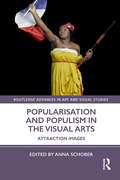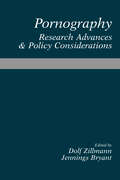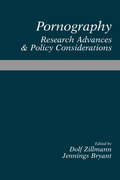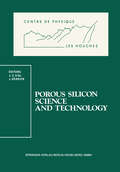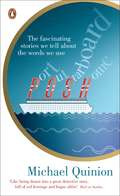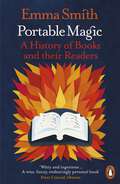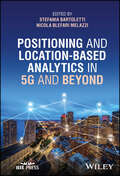- Table View
- List View
Popularisation and Populism in the Visual Arts: Attraction Images (Routledge Advances in Art and Visual Studies)
by Anna SchoberThis book investigates the pictorial figurations, aesthetic styles and visual tactics through which visual art and popular culture attempt to appeal to "all of us". One key figure these practices bring into play—the "everybody" (which stands for "all of us" and is sometimes a "new man" or a "new woman")—is discussed in an interdisciplinary way involving scholars from several European countries. A key aspect is how popularisation and communication practices—which can assume populist forms—operate in contemporary democracies and where their genealogies lie. A second focus is on the ambivalences of attraction, i.e. on the ways in which visual creations can evoke desire as well as hatred.
Populismus: Gefahr für die Demokratie oder nützliches Korrektiv?
by Frank DeckerDieser Sammelband behandelt umfassend alle wesentlichen Aspekte des Populismus, seine Erscheinungsformen und seine Bedeutung und Funktion in einer Demokratie.
Populist Disinformation in Fragmented Information Settings: Understanding the Nature and Persuasiveness of Populist and Post-factual Communication (Routledge Studies in Media, Communication, and Politics)
by Michael HameleersIn this highly relevant work, Dr. Michael Hameleers illuminates the role of traditional and social media in shaping the political consequences of populism and disinformation in a mediatized era characterized by post-factual relativism and the perseverance of a populist zeitgeist. Using comparative empirical evidence collected in the US, the UK, and the Netherlands, this book explores the politics and discursive construction of populism and disinformation, how they co-occur, their effects on society, and the antidotes used to combat the consequences of these communicative phenomena. This book is an essential text for students and academics in communication, media studies, political science, sociology, and psychology.
Populist Disinformation in Fragmented Information Settings: Understanding the Nature and Persuasiveness of Populist and Post-factual Communication (Routledge Studies in Media, Communication, and Politics)
by Michael HameleersIn this highly relevant work, Dr. Michael Hameleers illuminates the role of traditional and social media in shaping the political consequences of populism and disinformation in a mediatized era characterized by post-factual relativism and the perseverance of a populist zeitgeist. Using comparative empirical evidence collected in the US, the UK, and the Netherlands, this book explores the politics and discursive construction of populism and disinformation, how they co-occur, their effects on society, and the antidotes used to combat the consequences of these communicative phenomena. This book is an essential text for students and academics in communication, media studies, political science, sociology, and psychology.
Populist Political Communication in Europe (Routledge Research in Communication Studies)
by Claes H. de Vreese Carsten Reinemann Frank Esser Toril Aalberg Jesper StrömbäckIn an increasing number of countries around the world, populist leaders, political parties and movements have gained prominence and influence, either by electoral successes on their own or by influencing other political parties and the national political discourse. While it is widely acknowledged that the media and the role of communication more broadly are key to understanding the rise and success of populist leaders, parties and movements, there is however very little research on populist political communication, at least in the English-speaking research literature. Originating from a research project funded by the European Cooperation in the field of Scientific and Technical Research (COST), this book seeks to advance this research. It includes examinations 24 European countries, and focuses on three areas within the context of populism and populist political communication: populist actors as communicators, the media and populism and citizens and populism.
Populist Political Communication in Europe (Routledge Research in Communication Studies)
by Carsten Reinemann Frank Esser Jesper Stromback Toril Aalberg Claes De VreeseIn an increasing number of countries around the world, populist leaders, political parties and movements have gained prominence and influence, either by electoral successes on their own or by influencing other political parties and the national political discourse. While it is widely acknowledged that the media and the role of communication more broadly are key to understanding the rise and success of populist leaders, parties and movements, there is however very little research on populist political communication, at least in the English-speaking research literature. Originating from a research project funded by the European Cooperation in the field of Scientific and Technical Research (COST), this book seeks to advance this research. It includes examinations 24 European countries, and focuses on three areas within the context of populism and populist political communication: populist actors as communicators, the media and populism and citizens and populism.
Pornography: Research Advances and Policy Considerations (Routledge Communication Series)
by Dolf Zillmann Jennings Bryant"...provides good coverage of the empirical literature."—Journal of Communication "...well written and presents a wide diversity of approaches to pornography."—CHOICE
Pornography: Research Advances and Policy Considerations (Routledge Communication Series)
by Dolf Zillmann Jennings Bryant"...provides good coverage of the empirical literature."—Journal of Communication "...well written and presents a wide diversity of approaches to pornography."—CHOICE
Porous Silicon Science and Technology: Winter School Les Houches, 8 to 12 February 1994 (Centre de Physique des Houches #1)
by Jean-Claude Vial Jacques DerrienThe discovery of bright visible light emission from porous silicon has opened the door to various nanometer sized silicon structures where the confinement of carriers gives rise to interesting physical properties. While the high efficiency of the light emission in the visible range is the common and the most prominent feature, their structures display similar properties with other highly divided materials (even non semiconductors), and then justify a multidisciplinary approach. This along with potential applications has attracted a large number of researchers followed by students to be trained. Until now international conferences have provided the exchange of information but have remained highly specialised so it was time to give thought to the organisation of topical and advanced lectures where the multidisciplinarity and the didactic approach are paramount. L'ecole des Houches was ideally devoted to that purpose. The meeting : " Luminescence of porous silicon and silicon nanostructures" was the first international school on this topic but some aspects in the organisation and the attendance have given an international workshop flavor to it. The school by itself has trained 82 «students», most of them were students starting their Ph. D thesis. 50% were French citizens and the other represented countries were Germany, England, USA, Czechoslovakia, The Netherlands, Italy, Japan, Poland, Spain, Canada, Brazil, India and Russia.
Port Out, Starboard Home: The Fascinating Stories We Tell About the words We Use
by Michael QuinionCan it really be true that 'golf' stands for 'Gentlemen Only Ladies Forbidden'? Or that 'rule of thumb' comes from an archaic legal principle that a man may chastise his wife, but only with a rod no thicker than his thumb?These and hundreds of other stories are commonly told and retold whenever people meet. They grow up in part because expressions are often genuinely mysterious. Why, for example, are satisfying meals 'square' rather than any other shape? And how did anyone ever come up with the idea that if you're competent at something you can 'cut the mustard'?Michael Quinion here retells many of the more bizarre tales, and explains their real origins where they're known. This is a fascinating treasure-trove of fiction and fact for anyone interested in language.
Portable Magic: A History of Books and their Readers
by Emma Smith'A fascinating journey into our relationship with the physical book...I lost count of the times I exclaimed with delight when I read a nugget of information I hadn't encountered before' Val McDermid, The TimesMost of what we say about books is really about the words inside them: the rosy nostalgic glow for childhood reading, the lifetime companionship of a much-loved novel. But books are things as well as words, objects in our lives as well as worlds in our heads. And just as we crack their spines, loosen their leaves and write in their margins, so they disrupt and disorder us in turn. All books are, as Stephen King put it, 'a uniquely portable magic'. Here, Emma Smith shows us why.Portable Magic unfurls an exciting and iconoclastic new story of the book in human hands, exploring when, why and how it acquired its particular hold over us. Gathering together a millennium's worth of pivotal encounters with volumes big and small, Smith reveals that, as much as their contents, it is books' physical form - their 'bookhood' - that lends them their distinctive and sometimes dangerous magic. From the Diamond Sutra to Jilly Cooper's Riders, to a book made of wrapped slices of cheese, this composite artisanal object has, for centuries, embodied and extended relationships between readers, nations, ideologies and cultures, in significant and unpredictable ways. Exploring the unexpected and unseen consequences of our love affair with books, Portable Magic hails the rise of the mass-market paperback, and dismantles the myth that print began with Gutenberg; it reveals how our reading habits have been shaped by American soldiers, and proposes new definitions of a 'classic'-and even of the book itself. Ultimately, it illuminates the ways in which our relationship with the written word is more reciprocal - and more turbulent - than we tend to imagine.
Portfolio Management: How to Innovate and Invest in Successful Projects
by Shan RajegopalIn Portfolio Management , Shan Rajegopal, a leading authority on innovation and project portfolio management, provides an integrated project portfolio management framework which links innovation, investment and implementation. A successful tried and tested method, this blueprint will be a hands-on guide for business executives.
The Position of the German Language in the World
by Ulrich AmmonThe Position of the German Language in the World focuses on the global position of German and the factors which work towards sustaining its use and utility for international communication. From the perspective of the global language constellation, the detailed data analysis of this substantial research project depicts German as an example of a second-rank language. The book also provides a model for analysis and description of international languages other than English. It offers a framework for strengthening the position of languages such as Arabic, Chinese, French, Portuguese, Spanish and others and for countering exaggerated claims about the global monopoly position of English. This comprehensive handbook of the state of the German language in the world was originally published in 2015 by Walter de Gruyter in German and has been critically acclaimed. Suitable for scholars and researchers of the German language, the handbook shows in detail how intricately and thoroughly German and other second-rank languages are tied up with a great number of societies and how these statistics support or weaken the languages’ functions and maintenance.
The Position of the German Language in the World
by Ulrich AmmonThe Position of the German Language in the World focuses on the global position of German and the factors which work towards sustaining its use and utility for international communication. From the perspective of the global language constellation, the detailed data analysis of this substantial research project depicts German as an example of a second-rank language. The book also provides a model for analysis and description of international languages other than English. It offers a framework for strengthening the position of languages such as Arabic, Chinese, French, Portuguese, Spanish and others and for countering exaggerated claims about the global monopoly position of English. This comprehensive handbook of the state of the German language in the world was originally published in 2015 by Walter de Gruyter in German and has been critically acclaimed. Suitable for scholars and researchers of the German language, the handbook shows in detail how intricately and thoroughly German and other second-rank languages are tied up with a great number of societies and how these statistics support or weaken the languages’ functions and maintenance.
Positioning and Location-based Analytics in 5G and Beyond
by Stefania Bartoletti Nicola Blefari-MelazziPOSITIONING AND LOCATION-BASED ANALYTICS IN 5G AND BEYOND Understand the future of cellular positioning with this introduction The fifth generation (5G) of mobile network technology are revolutionizing numerous aspects of cellular communication. Location information promises to make possible a range of new location-dependent services for end users and providers alike. With the new possibilities of this location technology comes a new demand for location-based analytics, a new paradigm for generating and analyzing dynamic location data for a wide variety of purposes. Positioning and Location-based Analytics in 5G and Beyond introduces the foundational concepts related to network localization, user positioning, and location-based analytics in the context of cutting-edge mobile networks. It includes information on current location-based technologies and their application, and guidance on the future development of location systems beyond 5G. The result is an accessible but rigorous guide to a bold new frontier in cellular technology. Positioning and Location-based Analytics in 5G and Beyond readers will also find: Contributions from leading researchers and industry professionals High-level insights into 5G and its future evolution In-depth coverage of subjects such as positioning enablers, location-aware network management, reference standard architectures, and more Positioning and Location-based Analytics in 5G and Beyond is ideal for researchers and industry professionals with an understanding of network communications and a desire to understand the future of the field.
Positioning and Location-based Analytics in 5G and Beyond
by Stefania Bartoletti; Nicola Blefari MelazziPOSITIONING AND LOCATION-BASED ANALYTICS IN 5G AND BEYOND Understand the future of cellular positioning with this introduction The fifth generation (5G) of mobile network technology are revolutionizing numerous aspects of cellular communication. Location information promises to make possible a range of new location-dependent services for end users and providers alike. With the new possibilities of this location technology comes a new demand for location-based analytics, a new paradigm for generating and analyzing dynamic location data for a wide variety of purposes. Positioning and Location-based Analytics in 5G and Beyond introduces the foundational concepts related to network localization, user positioning, and location-based analytics in the context of cutting-edge mobile networks. It includes information on current location-based technologies and their application, and guidance on the future development of location systems beyond 5G. The result is an accessible but rigorous guide to a bold new frontier in cellular technology. Positioning and Location-based Analytics in 5G and Beyond readers will also find: Contributions from leading researchers and industry professionals High-level insights into 5G and its future evolution In-depth coverage of subjects such as positioning enablers, location-aware network management, reference standard architectures, and more Positioning and Location-based Analytics in 5G and Beyond is ideal for researchers and industry professionals with an understanding of network communications and a desire to understand the future of the field.
Positioning Theory And Strategic Communication: A New Approach To Public Relations Research And Practice (Routledge New Directions In Public Relations And Communication Research Ser.)
by Melanie JamesIn public relations, people talk about positioning an idea, a persona, a political ideal, an ideology - but what are they talking about? Why do some positions taken by organizations crystallize in the minds of audiences, while others fail? Whilst positioning is not something new in public relations, this book is the first to explicate what it involves, how it works and how to do it. This is the first in-depth exploration of the possibilities of Positioning Theory for the public relations field and it adds a new perspective to the growing body of multidisciplinary work in this rich theoretical area, moving the discussion away from the traditional communication plans of previous decades, which fail to accommodate the changing media and opinion landscapes. The author pulls together various strands of socio-cultural theory into an analytical framework, providing readers with a tool to analyse the organizational implications of public relations decisions, guiding strategic decision making through realistic scenario planning. This thought-provoking book provides an alternative path to studying communication in increasingly complex environments and as such, will be vital reading for researchers and educators, advanced communication and public relations students, and for senior public relations practitioners.
Positioning Theory and Strategic Communication: A new approach to public relations research and practice (Routledge New Directions in PR & Communication Research)
by Melanie JamesIn public relations, people talk about positioning an idea, a persona, a political ideal, an ideology – but what are they talking about? Why do some positions taken by organizations crystallize in the minds of audiences, while others fail? Whilst positioning is not something new in public relations, this book is the first to explicate what it involves, how it works and how to do it. This is the first in-depth exploration of the possibilities of Positioning Theory for the public relations field and it adds a new perspective to the growing body of multidisciplinary work in this rich theoretical area, moving the discussion away from the traditional communication plans of previous decades, which fail to accommodate the changing media and opinion landscapes. The author pulls together various strands of socio-cultural theory into an analytical framework, providing readers with a tool to analyse the organizational implications of public relations decisions, guiding strategic decision making through realistic scenario planning. This thought-provoking book provides an alternative path to studying communication in increasingly complex environments and as such, will be vital reading for researchers and educators, advanced communication and public relations students, and for senior public relations practitioners.
Positioning Theory and Strategic Communication: A new approach to public relations research and practice (Routledge New Directions in PR & Communication Research)
by Melanie JamesIn public relations, people talk about positioning an idea, a persona, a political ideal, an ideology – but what are they talking about? Why do some positions taken by organizations crystallize in the minds of audiences, while others fail? Whilst positioning is not something new in public relations, this book is the first to explicate what it involves, how it works and how to do it. This is the first in-depth exploration of the possibilities of Positioning Theory for the public relations field and it adds a new perspective to the growing body of multidisciplinary work in this rich theoretical area, moving the discussion away from the traditional communication plans of previous decades, which fail to accommodate the changing media and opinion landscapes. The author pulls together various strands of socio-cultural theory into an analytical framework, providing readers with a tool to analyse the organizational implications of public relations decisions, guiding strategic decision making through realistic scenario planning. This thought-provoking book provides an alternative path to studying communication in increasingly complex environments and as such, will be vital reading for researchers and educators, advanced communication and public relations students, and for senior public relations practitioners.
Positioning Theory And Strategic Communication: A New Approach To Public Relations Research And Practice (Routledge New Directions In Public Relations And Communication Research Ser.)
by Melanie JamesIn public relations, people talk about positioning an idea, a persona, a political ideal, an ideology - but what are they talking about? Why do some positions taken by organizations crystallize in the minds of audiences, while others fail? Whilst positioning is not something new in public relations, this book is the first to explicate what it involves, how it works and how to do it. This is the first in-depth exploration of the possibilities of Positioning Theory for the public relations field and it adds a new perspective to the growing body of multidisciplinary work in this rich theoretical area, moving the discussion away from the traditional communication plans of previous decades, which fail to accommodate the changing media and opinion landscapes. The author pulls together various strands of socio-cultural theory into an analytical framework, providing readers with a tool to analyse the organizational implications of public relations decisions, guiding strategic decision making through realistic scenario planning. This thought-provoking book provides an alternative path to studying communication in increasingly complex environments and as such, will be vital reading for researchers and educators, advanced communication and public relations students, and for senior public relations practitioners.
The Positive Case for Negative Campaigning
by Kyle Mattes David P. RedlawskTurn on the television or sign in to social media during election season and chances are you’ll see plenty of negative campaigning. For decades, conventional wisdom has held that Americans hate negativity in political advertising, and some have even argued that its pervasiveness in recent seasons has helped to drive down voter turnout. Arguing against this commonly held view, Kyle Mattes and David P. Redlawsk show not only that some negativity is accepted by voters as part of the political process, but that negative advertising is necessary to convey valuable information that would not otherwise be revealed. The most comprehensive treatment of negative campaigning to date, The Positive Case for Negative Campaigning uses models, surveys, and experiments to show that much of the seeming dislike of negative campaigning can be explained by the way survey questions have been worded. By failing to distinguish between baseless and credible attacks, surveys fail to capture differences in voters’ receptivity. Voters’ responses, the authors argue, vary greatly and can be better explained by the content and believability of the ads than by whether the ads are negative. Mattes and Redlawsk continue on to establish how voters make use of negative information and why it is necessary. Many voters are politically naïve and unlikely to make inferences about candidates’ positions or traits, so the ability of candidates to go on the attack and focus explicitly on information that would not otherwise be available is crucial to voter education.
The Positive Case for Negative Campaigning
by Kyle Mattes David P. RedlawskTurn on the television or sign in to social media during election season and chances are you’ll see plenty of negative campaigning. For decades, conventional wisdom has held that Americans hate negativity in political advertising, and some have even argued that its pervasiveness in recent seasons has helped to drive down voter turnout. Arguing against this commonly held view, Kyle Mattes and David P. Redlawsk show not only that some negativity is accepted by voters as part of the political process, but that negative advertising is necessary to convey valuable information that would not otherwise be revealed. The most comprehensive treatment of negative campaigning to date, The Positive Case for Negative Campaigning uses models, surveys, and experiments to show that much of the seeming dislike of negative campaigning can be explained by the way survey questions have been worded. By failing to distinguish between baseless and credible attacks, surveys fail to capture differences in voters’ receptivity. Voters’ responses, the authors argue, vary greatly and can be better explained by the content and believability of the ads than by whether the ads are negative. Mattes and Redlawsk continue on to establish how voters make use of negative information and why it is necessary. Many voters are politically naïve and unlikely to make inferences about candidates’ positions or traits, so the ability of candidates to go on the attack and focus explicitly on information that would not otherwise be available is crucial to voter education.
The Positive Case for Negative Campaigning
by Kyle Mattes David P. RedlawskTurn on the television or sign in to social media during election season and chances are you’ll see plenty of negative campaigning. For decades, conventional wisdom has held that Americans hate negativity in political advertising, and some have even argued that its pervasiveness in recent seasons has helped to drive down voter turnout. Arguing against this commonly held view, Kyle Mattes and David P. Redlawsk show not only that some negativity is accepted by voters as part of the political process, but that negative advertising is necessary to convey valuable information that would not otherwise be revealed. The most comprehensive treatment of negative campaigning to date, The Positive Case for Negative Campaigning uses models, surveys, and experiments to show that much of the seeming dislike of negative campaigning can be explained by the way survey questions have been worded. By failing to distinguish between baseless and credible attacks, surveys fail to capture differences in voters’ receptivity. Voters’ responses, the authors argue, vary greatly and can be better explained by the content and believability of the ads than by whether the ads are negative. Mattes and Redlawsk continue on to establish how voters make use of negative information and why it is necessary. Many voters are politically naïve and unlikely to make inferences about candidates’ positions or traits, so the ability of candidates to go on the attack and focus explicitly on information that would not otherwise be available is crucial to voter education.
The Positive Case for Negative Campaigning
by Kyle Mattes David P. RedlawskTurn on the television or sign in to social media during election season and chances are you’ll see plenty of negative campaigning. For decades, conventional wisdom has held that Americans hate negativity in political advertising, and some have even argued that its pervasiveness in recent seasons has helped to drive down voter turnout. Arguing against this commonly held view, Kyle Mattes and David P. Redlawsk show not only that some negativity is accepted by voters as part of the political process, but that negative advertising is necessary to convey valuable information that would not otherwise be revealed. The most comprehensive treatment of negative campaigning to date, The Positive Case for Negative Campaigning uses models, surveys, and experiments to show that much of the seeming dislike of negative campaigning can be explained by the way survey questions have been worded. By failing to distinguish between baseless and credible attacks, surveys fail to capture differences in voters’ receptivity. Voters’ responses, the authors argue, vary greatly and can be better explained by the content and believability of the ads than by whether the ads are negative. Mattes and Redlawsk continue on to establish how voters make use of negative information and why it is necessary. Many voters are politically naïve and unlikely to make inferences about candidates’ positions or traits, so the ability of candidates to go on the attack and focus explicitly on information that would not otherwise be available is crucial to voter education.
The Positive Case for Negative Campaigning
by Kyle Mattes David P. RedlawskTurn on the television or sign in to social media during election season and chances are you’ll see plenty of negative campaigning. For decades, conventional wisdom has held that Americans hate negativity in political advertising, and some have even argued that its pervasiveness in recent seasons has helped to drive down voter turnout. Arguing against this commonly held view, Kyle Mattes and David P. Redlawsk show not only that some negativity is accepted by voters as part of the political process, but that negative advertising is necessary to convey valuable information that would not otherwise be revealed. The most comprehensive treatment of negative campaigning to date, The Positive Case for Negative Campaigning uses models, surveys, and experiments to show that much of the seeming dislike of negative campaigning can be explained by the way survey questions have been worded. By failing to distinguish between baseless and credible attacks, surveys fail to capture differences in voters’ receptivity. Voters’ responses, the authors argue, vary greatly and can be better explained by the content and believability of the ads than by whether the ads are negative. Mattes and Redlawsk continue on to establish how voters make use of negative information and why it is necessary. Many voters are politically naïve and unlikely to make inferences about candidates’ positions or traits, so the ability of candidates to go on the attack and focus explicitly on information that would not otherwise be available is crucial to voter education.
